
The Blue Riband is an unofficial accolade given to the passenger liner crossing the Atlantic Ocean in regular service with the record highest average speed. The term was borrowed from horse racing and was not widely used until after 1910. The record is based on average speed rather than passage time because ships follow different routes. Also, eastbound and westbound speed records are reckoned separately, as the more difficult westbound record voyage, against the Gulf Stream and the prevailing weather systems, typically results in lower average speeds.
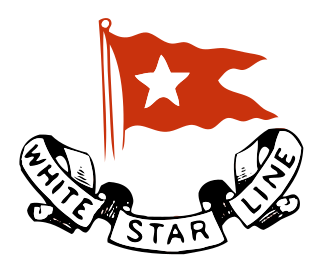
The White Star Line was a British shipping line. Founded out of the remains of a defunct packet company, it gradually rose up to become one of the most prominent shipping companies in the world, providing passenger and cargo services between the British Empire and the United States. While many other shipping lines focused primarily on speed, White Star branded their services by focusing more on providing comfortable passages for both upper class travellers and immigrants.

SS Bothnia was a British steam passenger ship that sailed on the trans-Atlantic route between Liverpool and New York City or Boston. The ship was built by J & G Thomson of Clydebank, and launched on 4 March 1874 for the British & North American Royal Mail Steam Packet Company, which became the Cunard Line in 1879.

RMS Carmania was a Cunard Line transatlantic steam turbine ocean liner. She was launched in 1905 and scrapped in 1932. In World War I she was first an armed merchant cruiser (AMC) and then a troop ship.
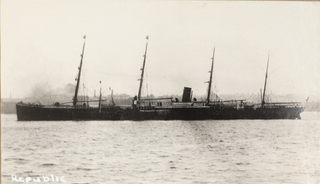
SS Republic was an ocean liner built in 1871 by Harland and Wolff for White Star Line. It was intended to be the last of four vessels forming the Oceanic-class, before two new ships were commissioned. After a rough maiden voyage from Liverpool to New York City on 1 February 1872, the ship was chosen to be on White Star Line's first voyage on the South Atlantic and Pacific line with four other ships, destined for Chile. In 1874, the construction of modern ships SS Germanic and SS Britannic led to SS Republic's becoming the standby vessel of White Star Line. It occupied this position for 15 years, and attempts were made to modernise it in 1888. When RMS Teutonic and RMS Majestic entered service in the following year, the Republic became surplus to White Star's needs.
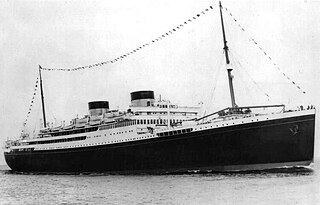
MV Britannic was a British transatlantic ocean liner that was launched in 1929 and scrapped in 1961. She was the penultimate ship built for White Star Line before its 1934 merger with Cunard Line. When built, Britannic was the largest motor ship in the UK Merchant Navy. Her running mate ship was the MV Georgic.

SS Servia, also known as RMS Servia, was a successful transatlantic passenger and mail steamer of revolutionary design, built by J & G Thomson of Clydebank and launched in 1881. She was the first large ocean liner to be built of steel instead of iron, and the first Cunard ship to have an electric lighting installation.

MV Georgic was the last ship built for the White Star Line before its merger with the Cunard Line. Built at Harland and Wolff shipyard in Belfast, she was the running mate of MV Britannic. Like Britannic, Georgic was a motorship, and not a steamer, fitted with a diesel powerplant. At the time of her launch in 1931, she was the largest British motorship.

Arizona was a record breaking British passenger liner that was the first of the Guion Line's Atlantic Greyhounds on the Liverpool-Queenstown-New York route. One nautical historian called Arizona "a souped up transatlantic hot rod." Entering service in 1879, she was the prototype for Atlantic express liners until the Inman Line introduced its twin screw City of New York in 1889. The Arizona type liner is generally considered as unsuccessful because too much was sacrificed for speed. Laid up in 1894 when Guion stopped sailings, Arizona was sold four years later and briefly employed in the Pacific until she was acquired by the US Government for service in the Spanish–American War. As the US Navy's Hancock she continued trooping through World War I, and was scrapped in 1926.
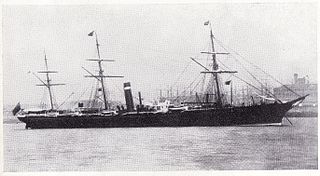
City of Paris was a British passenger liner operated by the Inman Line that established that a ship driven by a screw could match the speed of the paddlers on the Atlantic crossing. Built by Tod and Macgregor, she served the Inman Line until 1884 when she was converted to a cargo ship.

City of Brussels was a British passenger liner that set the record for the fastest Atlantic eastbound voyage in 1869, becoming the first record breaker driven by a screw. Built by Tod and Macgregor, she served the Inman Line until 1883 when she sank with the loss of ten people after a collision while entering the Mersey.

SS Lapland was a steam ocean liner built in Ireland for the Belgian Red Star Line, as Red Star's flagship, similar in appearance to the fellow liners SS Samland, SS Gothland and SS Poland, but far larger. She was a half sister to White Star Line's "Big Four." They were similar in many ways, such as the island bridge, 4 masts, 2 funnels. But Lapland had a less luxurious interior.
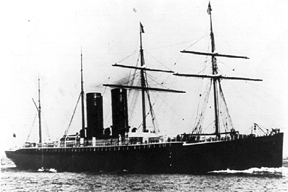
SS Oregon was a record-breaking British passenger liner that won the Blue Riband for the Guion Line as the fastest liner on the Atlantic in 1884. She was sold to the Cunard Line after a few voyages and continued to improve her passage times for her new owner. In 1885, Oregon was chartered to the Royal Navy as an auxiliary cruiser, and her success in this role resulted in the Admiralty subsidizing suitable ships for quick conversion in the event of a crisis. She returned to Cunard service in November 1885 and four months later collided with a schooner while approaching New York. Virtually all persons on board were rescued before Oregon sank. Her wreck, 18 miles south of Long Island, remains a popular diving site.

Scotia was a British passenger liner operated by the Cunard Line that won the Blue Riband in 1863 for the fastest westbound transatlantic voyage. She was the last oceangoing paddle steamer, and as late as 1874 she made Cunard's second fastest voyage. Laid up in 1876, Scotia was converted to a twin-screw cable layer in 1879. She served in her new role for twenty-five years until she was wrecked off of Guam in March 1904.

Persia was a British passenger liner operated by the Cunard Line that won the Blue Riband in 1856 for the fastest westbound transatlantic voyage. She was the first Atlantic record breaker constructed of iron and was the largest ship in the world at the time of her launch. However, the inefficiencies of paddle wheel propulsion rendered Persia obsolete and she was taken out of service in 1868 after only twelve years. Attempts to convert Persia to sail were unsuccessful and the former pride of the British merchant marine was scrapped in 1872.

SS Calgaric was a steam ocean liner that was completed in 1917, assumes service in 1918 and scrapped in 1934. She was built for the Pacific SN Co Line as Orca. In 1923 she was transferred to the Royal Mail Line. In 1927 she was transferred to White Star Line and renamed Calgaric.

The Oceanic class were a group of six ocean liners built by Harland and Wolff at Belfast, for the White Star Line, for the transatlantic service. They were the company's first generation of steamships to serve the North Atlantic passenger trade, entering service between 1871 and 1872.

SS Westernland was a transatlantic ocean liner that was launched as Regina in Scotland in 1917, renamed Westernland in 1929 and was scrapped in 1947. She began her career as a troop ship repatriating US troops after the Armistice of 11 November 1918. In the Second World War, Westernland served as a troop ship, repair ship and destroyer depot ship.

SS Vauban was a 1912 steam ocean liner operated by Lamport and Holt Line and used on its service between New York and the River Plate. She was named after the French military engineer Sébastien Le Prestre de Vauban (1633–1707). She was a troop ship in the First World War, resumed passenger service until 1930 and was scrapped in 1932.

RMS Hecla was an ocean liner for the Cunard Line, built in 1860 and scrapped in 1954. As of 2024, she is the longest surviving vessel built for the company, lasting 94 years.




















